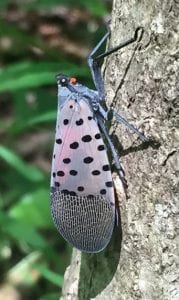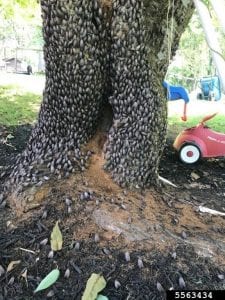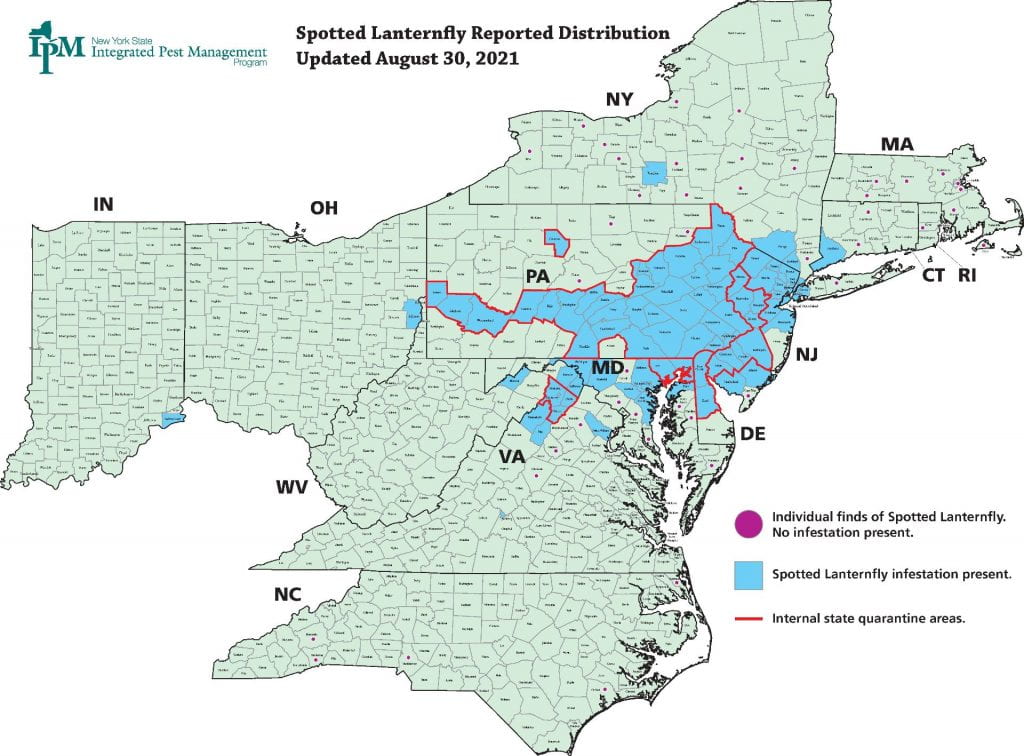Spotted Lanternfly: a new, unwelcome invader!
adapted from an article by Jen Lerner – Senior Resource Educator, Cornell Cooperative Extension of Putnam County
Updated September 7, 2021

Here in the Hudson Valley, we have weathered waves of invasion . . . Insect invasion that is. Think of the multicolored Asian lady beetle buzzing around your house, soon replaced by the brown marmorated stinkbug dive-bombing your reading light at night. The emerald ash borer followed, and we see our native ash trees, their bark chipped away by woodpeckers foraging for larvae, standing as reminders that our actions have far-reaching impacts. Enter the newest invader. . .

The spotted lanternfly (Lycorma delicatula) is a colorful insect in the planthopper family that congregates in large numbers to feed on the sap of trees. As it feeds, it excretes “honeydew” a nice name for what is essentially a sticky excrement. That honeydew sometimes alerts people to the presence of the pest.
While the honeydew is a nuisance, the strain placed on the trees’ resources by the insects feeding weakening the tree. The spotted lanternfly’s preferred host, the Tree-of-Heaven (Ailanthus altissima), is also an unwanted invader despite its heavenly moniker. Great, you say? Maybe the lanternfly will polish off the Tree of Heaven? Well these gregarious insects have a few more tricks up their spotted sleeves.
Why are we worried?

Like the brown marmorated stinkbug, spotted lanternflies are a pest of some important agricultural crops. They feed on and harm many fruit producing plants, including apples, peaches, plums, blueberries and grapes, as well as approximately 70 other plants. Besides the far-reaching economic impacts, there are ecological considerations too. Many of these trees and shrubs have relatives in our native ecosystem. For example, our native Shadblow or Serviceberry (Amelanchier sp.) is a close relative of the apple. It provides important forage for migratory birds who return to their nesting sites expecting to find its nutritious early fruits. Imagine the hole their loss would make in our ecosystem. We simply do not know yet how many host plants this insect can survive on or how wide their impact will be.
How can You Help?
 Keep on the lookout and report your observations. Learn to recognize the insects themselves as well as the signs of the spotted lanternfly. While the insect may be easy to spot because of its bright spots, the egg clusters are harder to spy. They are tan to light grey, laid in row and sometimes covered with a mud-like protective layer. If you see the insects or spot the egg clusters, please report the sighting to the NYS DEC using their online reporting form.
Keep on the lookout and report your observations. Learn to recognize the insects themselves as well as the signs of the spotted lanternfly. While the insect may be easy to spot because of its bright spots, the egg clusters are harder to spy. They are tan to light grey, laid in row and sometimes covered with a mud-like protective layer. If you see the insects or spot the egg clusters, please report the sighting to the NYS DEC using their online reporting form.
Don’t help them spread!
Though spotted lanternflies may hitch a ride on a boat, trailer, or vehicle, their egg clusters pose the most insidious risk because the female will lay them on just about anything!
Hitchhiking egg masses can be found on pallets of stone, firewood shipments, Christmas trees, and outdoor furniture. Remember . . . never take firewood from your home to a favorite campground or weekend retreat. Similarly don’t pick up wood from far away and bring it home: you may be bringing a hidden invader with you. Observe the “Don’t Move Firewood” rule. Inspect boats and trailers for hitchhiking egg masses. If purchasing used outdoor furniture, or items frequently stored outside like garden tools and wheelbarrows, check all surfaces for egg masses. Yes, the adult insects can fly, but they spread much more quickly when humans help them along.
How did they get here? And how far have they spread?
Spotted lanternfly is native to China, India, and Vietnam. This insect was introduced into South Korea and spread throughout the country (approximately the size of Pennsylvania) in 3 years. On this side of the world, an initial infestation was found in Berks County, Pennsylvania, in 2014. This first infestation is thought to have arrived on a shipment of stone in 2012. This highly invasive insect has spread from Pennsylvania into the surrounding states including New York where in 2020 populations were found on Staten Island as well as in Orange, Rockland and Tompkins counties.
Spotted Lanternfly – NYS DEC
Spotted Lanternfly – NYS IPM
Spotted Lanternfly Look-Alikes (Eggs, Nymphs & Adults) – Virginia Cooperative Extension
VIDEO: Introduction to Spotted Lanternfly – NYSIPM
More Photos of Adults, Nymphs, and Eggs – USDA
Spotted Lanternfly Management Resources – Penn State Extension


